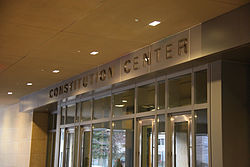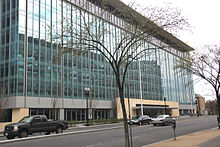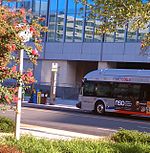- Constitution Center (Washington, D.C.)
-
This article is about the Washington, D.C., office building recently renamed "Constitution Center". For the museum in Philadelphia, see National Constitution Center.
Constitution Center 
Former names David Nassif Building General information Type Office Location 400 7th Street SW, Washington, D.C., U.S. Coordinates 38°53′01″N 077°01′19″W / 38.88361°N 77.02194°WCoordinates: 38°53′01″N 077°01′19″W / 38.88361°N 77.02194°W Construction started 1968 Completed 1969 Cost $26.5 million (1969); $220 million (2006 renovation) Height Roof 140 feet (43 m) Technical details Floor count 10 Floor area 1,400,000 sq ft (130,000 m2) Design and construction Owner Nassif Associates Main contractor Volpe Construction (1969); Davis Construction (2006) Architect Edward Durrell Stone (1969); SmithGroup (2006) Developer David Nassif, Sr. Constitution Center[1] (formerly known as the David Nassif Building) is an office building located at 400 7th Street SW in Washington, D.C.[2] It is 140 feet (43 m) high and has 10 floors.[3] Covering an entire city block, it is the largest privately owned office building in the District of Columbia.[3] Current tenants include the United States Securities and Exchange Commission[2] and the Office of the Comptroller of the Currency.[4]
Contents
Original structure
In the 1950s, the U.S. Congress, then the governing institution of the District of Columbia, undertook the Southwest D.C. urban renewal project, the first in the capital district and one of the earliest such programs in the nation.[5] In 1946, Congress passed the District of Columbia Redevelopment Act, which established the District of Columbia Redevelopment Land Agency (RLA) and provided legal authority to clear land and funds to spur redevelopment in the capital.[6] Congress also gave the National Capital Planning Commission (NCPC) the authority to designate which land would be redeveloped, and how.[7] The RLA was not funded, however, until passage of the Housing Act of 1949.[7] A 1950 study by the NCPC found that the small Southwest quarter of the city suffered from high concentrations of old and poorly maintained buildings, overcrowding, and threats to public health (such as lack of running indoor water, sewage systems, electricity, central heating, and indoor toilets).[5][8] Competing visions for the redevelopment ranged from renovation to wholesale leveling of neighborhoods, but the latter view prevailed as more likely to qualify for federal funding.[9] Original plans called for the demolition of almost all structures in Southwest Washington beginning in 1950, but legal challenges led to piecemeal razing of the area until the mid-1950s.
Issues surrounding the planning and construction of L'Enfant Plaza (immediately to the west of the site) delayed construction of any buildings on the block until the late 1960s. In 1963, the RLA purchased the land from the Westminster Memorial Church, Fifth Baptist Church, and homeowners.[10][11] The United States Department of Health, Education and Welfare wished to purchase the site for its new headquarters, but the RLA declined to sell the property.[10] (The federal government does not pay taxes on land and structures it owns, and the RLA wanted a private owner who would add to the tax base.) The RLA attempted to sell the land on January 29, 1965, but there were no buyers.[10]
The building was constructed pursuant to an agreement between the General Services Administration (GSA) and Boston developer David Nassif, Sr. In July 1965, President Lyndon B. Johnson began planning to unite various disparate transportation agencies into a new United States Department of Transportation.[12] GSA (the property owner and manager for the U.S. federal government) began seeking to lease or build a structure to house the new agency in late 1965.[10] Donald T. Kirwan, chief of GSA's leasing division, knew Nassif from a previous lease negotiation, and discussed with him the siting of a building and its size.[10] Nassif approached the RLA on April 21, 1966, and asked to buy the newly razed block of land bounded by 6th, 7th, D, and E Streets SW.[10] In May 1967, GSA sent a letter to Nassif advising him that it was likely to lease the entire structure he intended to build.[10] The $5.9 million land purchase was finalized on October 30, 1967.[10] The cost of the structure is unclear. On November 15, 1967, Nassif had secured a $39 million construction loan.[10] But The Washington Post pegged the cost of the building at $27 million in July 1968.[13] The newspaper said in August 1970 that the cost of the structure was $26.5 million.[10] The building was designed by architect Edward Durrell Stone, who also designed the John F. Kennedy Center for the Performing Arts.[1] On April 11, 1968, GSA leased the entire building from Nassif for 20 years for $98 million.[10][14] John A. Volpe Construction was the chief contractor.[10]
Construction began in July 1968 (although it was delayed for a very short time when unionized ironworkers at the site went on strike) [15] and was completed in 1969.[1] The main entrance faced 7th Street SW.[16] It included a central courtyard (open to the sky) which featured a fountain, footpaths, benches, and landscaping.[11][16] Four 15-foot (4.6 m) high arcades pierced the building in the center of the block on each side, creating access to the courtyard.[11][16] The facade's vertical marble ribs were obtained from the same quarry near Carrara, Italy, that provided the marble for the Kennedy Center.[17] The finished building had 10 floors, three basement floors, overhanging eaves, and 2,500,000 square feet (230,000 m2) of space (1,019,000 square feet (94,700 m2) of usable space).[10][18] It was the largest privately owned office building in the city at the time.[10]
Kirwan's contacts with Nassif later became the subject of a legal investigation. Kirwan not only shared inside information with Nassif about leasing plans of the GSA, he later invested in Nassif's D.C. business and became an officer in it.[10] This relationship (Kirwan left GSA in December 1966, before the letter indicating intention to lease was set to Nassif), and GSA's irregular leasing of the building, became public knowledge in August 1970.[10] An internal GSA audit was critical of the leasing process and the costs of the lease.[19]
That same month, refinancing of the building was called into question. In the U.S., it is common business practice for the initial lender to provide an interim loan (the "construction loan") to build a building. The interim loan is then paid off by a second lender, who becomes the mortgage lender and receives payments from the building's owner. Riggs Bank, a local D.C. bank, had provided the interim construction loan to Nassif. The New York City Employees Retirement System was to have paid off this construction loan. That payment was halted when the loan officer Nassif had dealt with was indicted for taking bribes to approve loans.[14] When the pension fund refused to provide the loan, Riggs Bank sued for payment and threatened to foreclose on the Nassif Building.[20]
From 1969 until 2007, the Nassif Building served as the headquarters of the U.S. Department of Transportation (DOT).[1] The building was designed to have removable interior walls to permit easy reconfiguration of the interior space.[21] In November 1970, the federal government exercised its powers of eminent domain and seized control of the three-story basement parking garage from Nasif in order to provide inexpensive parking for DOT workers.[22] Over the years, so many government workers complained of ailments while working in the structure that some believed it suffered from sick building syndrome.[1] David Nassif Associates, owner of the building, disputed these claims.[1] However, when the Department of Transportation announced it would leave the building in 2000,[23] the owners promised a $100 million renovation that included a new air ventilation and cleaning system as an inducement for the agency to stay.[1] The owners also unsuccessfully sued the General Services Administration in 1999 to force it to renew the federal lease on the building.[1] The Department of Transportation completed their move out of the Nassif Building and into their new headquarters in June 2007.
The L'Enfant Plaza Metro station opened an escalator entrance in the structure's north arcade on July 1, 1977.[11][24] The entrance was one of two which opened that day (Metro Blue Line's opening day).[24] The third entrance (inside the L'Enfant Promenade underground shopping center at L'Enfant Plaza) opened in October 1977.[24] In June 1992, Virginia Railway Express opened the $1.1 million VRE L'Enfant Station on Virginia Avenue SE (about a half block north of Constitution Center).[25]
Renovation
In 2006, Nassif Associates announced a $220 million renovation of the building and renamed it "Constitution Center".[1] SmithGroup was the architectural firm overseeing the redesign,[26] and Davis Construction oversaw the construction.[27]
The renovation included some of the highest security features of any building in the D.C. area. They included a central and perimeter security system, closing of the central plaza of the building, which, along with other changes, increased its interior footage by 80,000 square feet (7,400 m2), steel-jacketed underground parking garage columns capable of withstanding a powerful explosion, and six fully staffed security screening points.[1][3] A 10,000-square-foot (930 m2) auditorium was added to the courtyard/plaza level.[28] The security enhancements made the office building suitable for all federal agencies with the exception of the United States Department of Defense.[1] The 700,000-square-foot (65,000 m2) underground parking garage contains 1,500 spaces.[28]
The exterior of the building was also radically changed. The celebrated key visual feature of the building,[21] its exterior vertical white marble ribbing, was completely removed after it was found to be bowed from age and weather.[1] Although this fundamentally changed the nature of Durrell's building, there was almost no public outcry.[21] It was replaced by an energy-efficient, all-glass facade.[1] Perhaps the most significant renovation feature was the structure's use of a chilled beam HVAC system, which uses chilled or heated water circulated in strategically placed columns in the interior space to cool and warm the building.[26] To test the efficiency of the chilled beam technology, the system was installed in the penthouse of the building and tested for a full year.[26] The architect agreed to use the system after the test outperformed specifications.[26] The installation represented the first large-scale use of the chilled beam technology in the United States.[29] Other energy-saving enhancements included motion and daylight detectors to turn lights off when not needed,[1] and special exterior windows which automatically dim to prevent daytime heating.[26] The building's ventilation system was also upgraded.[1] The renovation left the structure with 1,400,000 square feet (130,000 m2) of interior space.[2] The final cost of the renovation was pegged at $250 million.[3]
Some aesthetic improvements were made as well. The building now features a 1 acre (0.40 ha) park in its open-to-the-sky central courtyard.[3] Most of the courtyard's concrete was removed and trees, shrubs, and flowers planted to absorb rainwater.[3] The park, which is now no longer accessible by the public, also includes a very large granite abstract art sculpture ("Legacy") by Richard Deutsch.[3][30] The sculpture is meant to reflect the original facade of the building by Edward Durrell Stone as well as the memory of David Nassif, Sr. and his son, David Nassif, Jr..[30] The L'Enfant Plaza Metro station still has an entrance under the building on D Street SW (although this entrance closed between October 2007 and July 2008 for the building's reconstruction).[31] The renovation installed artwork by internationally-known artist Stephen Knapp near this entrance, in which strong beams of light are passed through dyed glass to splay brightly colored patterns on the ceiling.[3][30] The light sculpture, titled "Transformation", symbolizes the building's renovation and rebirth.[30]
The Constitution Center is registered with the Green Building Council for Gold LEED Certification.[28]
The renovated Constitution Center won two awards. The Mid-Atlantic Construction construction news Web site gave the building its "Project of the Year - Renovation/Restoration" accolade in December 2010.[28] On March 25, 2011, the Washington Building Congress bestowed its 2011 WBC Craftsmanship Award on J.E. Richards, Inc. for excellence in workmanship in installing the power generation, distribution, and switchgear at Constitution Center.[32]
Tenants
The late-2000s recession left the renovated building struggling to find tenants. It was empty for nearly two years after it was opened for occupancy in April 2009.[2] Both the United States Department of Homeland Security and NASA explored leasing all or part of it in 2009 and 2010, but chose not to do so.[2] In August 2010, the United States Securities and Exchange Commission (SEC) signed a lease for 900,000 square feet (84,000 m2) of space at Constitution Center.[2] The SEC planned to take occupancy in September 2011.[33] In January 2011, the Office of the Comptroller of the Currency agreed to lease the remaining space in the building.[4]
Footnotes
- ^ a b c d e f g h i j k l m n o Natarajan, Prabha. "Nassif Building Secures New Life After DoT Moves On." Washington Business Journal. December 4, 2006. Accessed 2011-04-20.
- ^ a b c d e f Krouse, Sarah. "SEC Takes Nearly 1 Million Square Feet at Constitution Center." Washington Business Journal. August 4, 2010. Accessed 2011-04-20.
- ^ a b c d e f g h Rein, Lisa. "Constitution Center: All Dressed Up but Missing a Suitor." Washington Post. October 2, 2009. Accessed 2011-04-20.
- ^ a b Krouse, Sarah. "OCC to Take Space at Constitution Center." Washington Business Journal. January 20, 2011. Accessed 2011-04-20.
- ^ a b Banks and Banks, 2004, p. 41.
- ^ Committee on the District of Columbia, 1978, p. 112.
- ^ a b Gutheim and Lee, 2006, p. 260.
- ^ Gutheim and Lee, 2006, p. 266-267.
- ^ Gutheim and Lee, 2006, p. 267-271; Banks and Banks, 2004, p. 42.
- ^ a b c d e f g h i j k l m n o p Kessler, Ronald. "GSA Ex-Aide Hits Jackpot on Lease." Washington Post. August 9, 1970.
- ^ a b c d Historic American Buildings Survey, p. 109. Accessed 2011-04-20.
- ^ Rose, Seely, and Barrett, 2006, p. 134.
- ^ Goodman, S. Oliver. "D.C. Building Plans Skyrocket in June." Washington Post. July 11, 1968.
- ^ a b Kessler, Ronald. "Indictment Stalls Loan On DOT Office Building." Washington Post. August 12, 1970.
- ^ Koprowski, Claude. "500 Striking Rodmen Tie Up 60 Local Building Projects." Washington Post. July 11, 1968.
- ^ a b c Sharkey, Jane. "Marble-Face Office Building to Rise in Capital." New York Times. October 1, 1967.
- ^ Historic American Buildings Survey, p. 109-110. Accessed 2011-04-20.
- ^ Historic American Buildings Survey, p. 110. Accessed 2011-04-20.
- ^ "GSA Keeps Wraps on Audit Of DOT Headquarters Rental." Washington Post. August 13, 1970.
- ^ Kessler, Ronald. "Riggs Bank, N.Y. Fund Sued On $39 Million D.C. Building." Washington Post. September 12, 1970; Kessler, Ronald. "Bribe Probe Snags DOT Building Loan." Washington Post. September 13, 1970.
- ^ a b c Grass, Michael E. "SEC to Expand Into Denuded Edward Durrell Stone Building." Washington City Paper. August 5, 2010. Accessed 2011-04-20.
- ^ Eisen, Jack. "U.S. Takes Over Parking Garage." Washington Post. November 5, 1970.
- ^ The Dept. of Transportation built a new headquarters at 1200 New Jersey Avenue SE, which it occupied as of June 2007. See: Haggery, Maryann. "Transportation Dept. Shops for New Headquarters Site." Washington Post. August 16, 1999; Spinner, Jackie. "GSA Picks 4 Sites For DOT Offices." Washington Post. March 11, 2000; "Contractors Move Forward on Transportation Building." Washington Business Journal. February 16, 2004, accessed 2011-04-20; "Green Roofs in the District - Showcase Projects." Department of the Environment. District of Columbia. April 10, 2009, accessed 2011-04-07.
- ^ a b c "Metro's Newest Stations: Where They Are, What's Nearby." Washington Post. June 24, 1977.
- ^ Masters, Brooke A. "Red Tape May Delay Va. Commuter Rail." Washington Post. April 4, 1991; Fehr, Stephen C. "Getting on Track." Washington Post. June 18, 1992.
- ^ a b c d e Fruehling, Douglas. "Chilled Beam System Comes to D.C." Washington Business Journal. November 26, 2007. Accessed 2011-04-20.
- ^ "On The List: James G. Davis Jr." Washington Business Journal. May 31, 2010. Accessed 2011-04-20.
- ^ a b c d "Constitution Center, Washington, D.C.: Project of the Year - Renovation/Restoration." Mid-Atlantic Construction. December 1, 2010. Accessed 2011-04-20.
- ^ Karidis, George. "Constitution Center Chills Out." Consulting Specifying Engineer. May 1, 2008.
- ^ a b c d "Art." Constitution Center. David Nassif Associates. 2009. Accessed 2011-03-13.
- ^ Grass, Michael. "L'Enfant Plaza Entrance to Close Until July '08." Express Night Out. October 8, 2007. Accessed 2011-04-20.
- ^ "2011 WBC Craftsmanship Awards Winners." Washington Building Congress. March 25, 2011. Accessed 2011-04-20.
- ^ Krouse, Sarah. "SEC Shifts 740 Va. Workers to Constitution Center." Washington Business Journal. January 6, 2011. Accessed 2011-04-20.
Bibliography
- Banks, James G. and Banks, Peter S. The Unintended Consequences: Family and Community, the Victims of Isolated Poverty. Lanham, Md.: University Press of America, 2004.
- Committee on the District of Columbia. Subcommittee on Fiscal and Government Affairs. Amend Redevelopment Act of 1945 and Transfer U.S. Real Property to RLA: Hearings and Markups Before the Subcommittee on Fiscal and Government Affairs and the Committee on the District of Columbia. U.S. House of Representatives. 95th Congress, Second Session. Washington, D.C.: U.S. Government Printing Office, 1978.
- Gutheim, Frederick A. and Lee, Antoinette J. Worthy of the Nation: Washington, D.C., From L'Enfant to the National Capital Planning Commission. Baltimore, Md.: Johns Hopkins University Press, 2006.
- Historic American Buildings Survey. Southwest Washington, Urban Renewal Area. HABS DC-856. DC-856. National Park Service. U.S. Department of the Interior. July 2004.
- Rose, Mark H.; Seely, Bruce Edsall; and Barrett, Paul F. The Best Transportation System in the World: Railroads, Trucks, Airlines, and American Public Policy in the Twentieth Century. Columbus, Ohio: Ohio State University Press, 2006.
External links
Categories:- Landmarks in Washington, D.C.
- United States Department of Transportation
- Buildings and structures completed in 1969
- Office buildings in Washington, D.C.
- Skyscrapers in Washington, D.C.
- Leadership in Energy and Environmental Design gold certified buildings
- Buildings and structures completed in 2009
Wikimedia Foundation. 2010.



